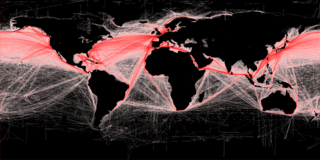User:Grolltech/Ocean Noise Pollution
| This is not a Wikipedia article: It is an individual user's work-in-progress page, and may be incomplete and/or unreliable. For guidance on developing this draft, see Wikipedia:So you made a userspace draft. Find sources: Google (books · news · scholar · free images · WP refs) · FENS · JSTOR · TWL |

Ocean Noise or Ocean Noise Pollution refers to unwanted sound within the earth's oceans. This underwater noise pollution, usually anthropogenic in origin, has many sources such as transportation and shipping, coastal construction (such as underwater percussive piling), offshore drilling and seismic exploration, and military sonar.
Marine animals such as whales, dolphins, and other marine mammals rely on their hearing for echolocation and communication with companions. A deafening environment might affect their ability to locate food, to navigate, and to communicate. It has also been shown to physiologically impact them by way of chronic stress.[1]
some terms to research:
- Background noise or ambient noise
- SONAR
- LRAD
Synonyms for redirect
Growing Awareness
[edit]- Resolution 9.19 the CMS Parties expressed concern about possible “adverse anthropogenic marine/ocean noise impacts on cetaceans and other biota”;
- other international fora have also began or continued to recognize man-made noise as a potential threat to cetacean conservation and welfare:
- International Maritime Organization (IMO)
- International Whaling Commission (IWC)
- Convention for the Protection of the Marine Environment of the North-East-Atlantic (OSPAR)
- Agreement on the Conservation of Small Cetaceans of the Baltic, North East Atlantic, Irish and North Seas (ASCOBANS)
- Agreement on the Conservation of Cetaceans in the Black Sea, Mediterranean Sea and contiguous Atlantic Area (ACCOBAMS)
- The United Nations General Assembly in its Resolution on "Oceans and the law of the sea", adopted on 20 December 2006 "encourages further studies and consideration of the impacts of ocean noise on marine living resources, and requests the Division1 to compile the peer-reviewed scientific studies it receives from Member States and to make them available on its website";
Effects on Marine Wildlife
[edit]A number of studies have suggested that human-induced noise pollution in the world's oceans also pose a threat to whales, dolphins, and other marine mammals. Baleen whales communicate using low-frequency acoustic signals. In sea water, sound travels more than 4 times faster and 100 times farther than it does in air.[2] A whale's call can thus travel hundreds of kilometers (even thousands of kilometers in the 'deep sound channel'[3]), allowing social contact over very large distances.[4] However, low-frequency (20–200 Hz) noise from large ships overlaps acoustic signals used by baleen whales, thus drowning out and inhibiting their communication. Reported responses of whales to increased noise include: habitat displacement, behavioral changes and alterations in the intensity, frequency and intervals of calls.[1]
Beyond these behavioral responses to noise, however, definitive evidence linking noise to any physiological impact on whales has remained elusive. The first clear evidence was found in a 2011 re-analysis and correlation of data that had been gathered during unrelated studies that were performed ten years earlier in the Bay of Fundy. After the September 11 attacks in 2001, there was an immediate and dramatic decline in shipping activity. This resulted in a 6 dB decrease in underwater noise with a significant reduction below 150 Hz. At the same time, another study showed decreased baseline levels of stress-related fecal hormone metabolites (glucocorticoids) in North Atlantic right whales. In other words, the whales were less stressed during this period. This is the first evidence that exposure to low-frequency ship noise may be associated with chronic stress in whales, and has implications for all baleen whales in heavy ship traffic areas, and for recovery of this endangered right whale population.[1]
See also
[edit]- Noise pollution
- Background noise
- Environmental impact of shipping
- Underwater acoustics
- Hydroacoustics
- Bioacoustics
- Noise and vibration on maritime vessels
- Whale sound
References
[edit]- ^ a b c Rolland, R. M.; Parks, S.E.; Hunt, K.E.; Castellote, M.; Corkeron, P.J.; Nowacek, D.P.; Wasser, S.K.; Kraus, S.D. (8 February 2012). "Evidence that ship noise increases stress in right whales". Proceedings of the Royal Society B: Biological Sciences. 279 (1737): 2363–2368. doi:10.1098/rspb.2011.2429. PMC 3350670. PMID 22319129. Retrieved 14 February 2012.
- ^ "Noise and Cetaceans". wildwhales.org. Wild Whales. Retrieved 14 February 2012.
- ^ Navy Supplement to the DOD Dictionary of Military and Associated Terms (PDF). Department Of The Navy. August 2006. NTRP 1-02.
- ^ Payne, R.; Webb, D. (1971). "Orientation by Means of Long Range Acoustic Signaling in Baleen Whales". Annals NY Acad. Sci. 188 (1): 110–41. Bibcode:1971NYASA.188..110P. doi:10.1111/j.1749-6632.1971.tb13093.x. PMID 5288850.[permanent dead link]
External links
[edit]- Ocean Conservation Research
- Don't be a Buckethead – "Manmade noise affects sea creatures like putting a bucket on your head"
- CMS Press Conference about Ocean Noise Pollution Archived 2011-07-22 at the Wayback Machine
- Right Whale Listening Network has acoustic autobuoys in between the lanes of the shipping lanes approaching Boston. A project of the Cornell Bioacoustics Research Program.

